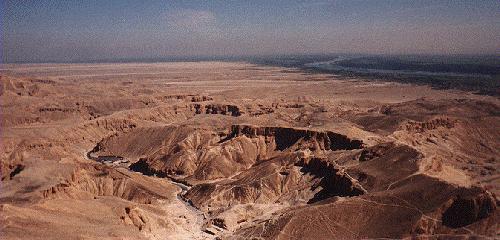
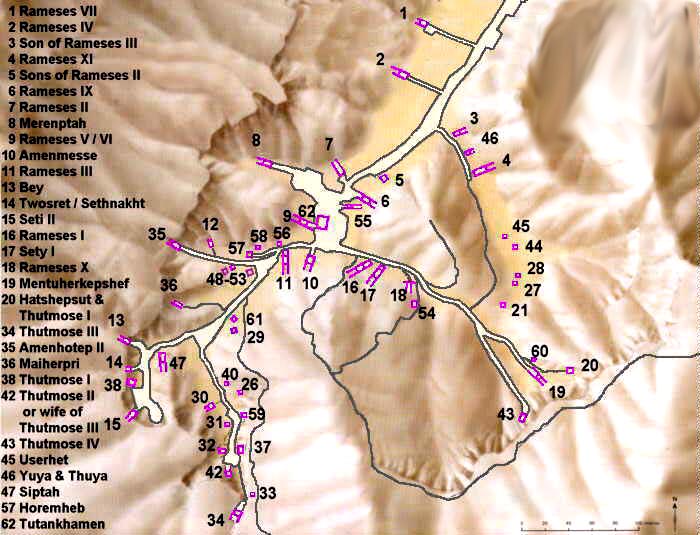
The Valley of the Kings is a valley in Egypt where for a period of nearly 500 years from the 16th to 11th century BC, tombs were constructed for the kings and powerful nobles of the New Kingdom (the Eighteenth through Twentieth Dynasties of Ancient Egypt).[2][3] The valley stands on the west bank of the Nile, across from Thebes (modern Luxor), within the heart of the Theban Necropolis. The wadi consists of two valleys, East Valley (where the majority of the royal tombs situated) and West Valley.
The area has been a focus of concentrated archaeological and egyptological exploration since the end of the eighteenth century, and its tombs and burials continue to stimulate research and interest. In modern times the valley has become famous for the discovery of the tomb of Tutankhamun (with its rumours of the Curse of the Pharaohs), and is one of the most famous archaeological sites in the world. In 1979, it became a World Heritage Site, along with the rest of the Theban Necropolis.
The Valley was used for primary burials from approximately 1539 BC to 1075 BC, and contains some 60 tombs, starting with Thutmose I and ending with Ramesses X or XI.
The Valley of the Kings also had tombs for the favourite nobles and the wives and children of both the nobles and pharaohs. Around the time of Ramesses I (ca. 1300 BC) the Valley of the Queens was begun, although some wives were still buried with their husbands.
The quality of the rock in the Valley is very inconsistent. Tombs were built, by cutting through various layers of limestone, each with its own quality. This poses problems for modern day conservators, as it must have to the original architects. Building plans were probably changed on account of this. The most serious problem are the shale layers. This fine material expands when it comes into contact with water. This has damaged many tombs, particularly during floods.
The Valley of the Kings, in Upper Egypt, Thebes, the burial place of the pharaohs of the New Kingdom, 18th, 19th, and 20th Dynasties.
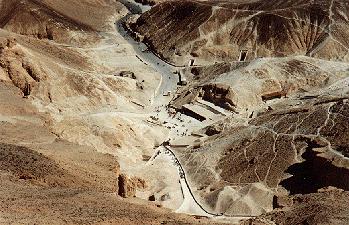
Most of the tombs were cut into the limestone following a similar pattern: three corridors, an antechamber and a sunken sarcophagus chamber. These catacombs were harder to rob and were more easily concealed. The switch to burying the pharaohs within the valley instead of pyramids, was intended to safeguard against tomb robbers. In most cases this did not prove to be affective. Many of the bodies, of the pharaohs, where moved by the Egyptian priests, and placed in several caches, during the political upheaval of the 21st Dynasty.
Construction of a tomb usually lasted six years, beginning with each new reign.
The text in the tombs are from the Book of the Dead, the Book of the Gates and the Book of the Underworld.
The Valley of the Kings has two components - the East Valley and the West Valley. It is the East Valley which most tourists visit and in which most of the tombs of the New Kingdom Pharaohs can be found.
By the end of the New Kingdom, Egypt had entered a long period of political and economic decline. The priests at Thebes grew in power and effectively administered Upper Egypt, while kings ruling from Tanis controlled Lower Egypt. The Valley began to be heavily plundered, so the priests of Amen during 21st Dynasty to open most of the tombs and move the mummies into three tombs in order to better protect them. Later most of these were moved to a single cache near Deir el-Bari. During the later Third Intermediate Period and later intrusive burials were introduced into many of the open tombs.
Almost all of the tombs have been ransacked, including Tutankhamun's, though in his case, it seems that the robbers were interrupted, so very little was removed.The valley was surrounded by steep cliffs and heavily guarded. In 1090 BC, or the year of the Hyena, there was a collapse in Egypt's economy leading to the emergence of tomb robbers. Because of this, it was also the last year that the valley was used for burial.The valley also seems to have suffered an official plundering during the virtual civil war which started in the reign of Ramesses XI. The tombs were opened, all the valuables removed, and the mummies collected into two large caches. One, the so-called Deir el-Bahri cache, contained no less than forty royal mummies and their coffins; the other, in the tomb of Amenhotep II, contained a further sixteen.
Exploring the Vally of the Kings
The Valley of the Kings has been a major area of modern Egyptological exploration for the last two centuries. Before this the area was a site for tourism in antiquity (especially during Roman times). This areas illustrates the changes in the study of ancient Egypt, starting as antiquity hunting, and ending as scientific excavation of the whole Theban Necropolis. Despite the exploration and investigation noted below, only eleven of the tombs have actually been completely recorded.
The Greek writers Strabo and Diodorus Siculus were able to report that the total number of Theban royal tombs was 47, of which at the time only 17 were believed to be undestroyed. Pausanias and others wrote of the pipe-like corridors of the Valley - i.e. the tombs.
Clearly others also visited the valley in these times, as many of the tombs have graffiti written by these ancient toursits. Jules Baillet located over 2000 Greek and Latin graffiti, along with a smaller number in Phoenician, Cypriot, Lycian, Coptic, and other languages.
Before the nineteenth century, travel from Europe to Thebes (and indeed anywhere in Egypt) was difficult, time-consuming and expensive, and only the hardiest of European travelers visited before the travels of Father Claude Sicard in 1726, it was unclear just where Thebes really was. It was known to be on the Nile, but it was often confused with Memphis and several other sites. One of the first travelers to record what he saw at Thebes was Frederic Louis Norden, a Danish adventurer and artist. He was followed by Richard Pococke, who published the first modern map of the valley itself, in 1743.
In 1799, Napoleon's expedition drew maps and plans of the known tombs, and for the first time noted the Western Valley (where Prosper Jollois and Édouard de Villiers du Terrage located the tomb of Amenhotep III, WV22). The Description de l'Égypte contains two volumes (out a total of 19) on the area around Thebes.
Nineteenth Century
European exploration continued in the area around Thebes during the Nineteenth Century, boosted by Champollion's translation of hieroglyphs early in the century. Early in the century, the area was visited by Belzoni, working for Henry Salt, who discovered several tombs, including that of those of Ay in the West Valley (WV23) in 1816, and Seti I, KV17 the next year. At the end of his visits, Belzoni declared that all of the tombs had been found and nothing of note remained to be found.
In 1827 John Gardiner Wilkinson was assigned to paint the entry of every tomb, giving them each a designation that is still in use today they were numbered from KV1 to KV21 (although the maps show 28 entrances, some of which were unexplored). These paintings and maps were later published in The Topography of Thebes and General Survey of Egypt, in 1830. At the same time James Burton explored the valley. His works included making KV17 safer from flooding, but he is more well known for entering KV5.
In 1829, Champollion himself visited the valley, along with Ippolitio Rosellini. The expedition spend 2 months studying the open tombs, visiting about 16 of them. The copied the enscriptions and identfied the original tomb owners. In the tomb of KV17, they removed some wall decorations, which are now on dispaly in the Louvre, Paris.
In 1845 - 1846 the valley was explored by Carl Richard Lepsius' expedition, they explored and documented 25 main valley and 4 in the west.The later half of the century saw a more concerted effort to preserve rather than simply gathering antiquities. Auguste Mariette's Egyptian Antiqities Service started to explore the valley, first with Eugéne Lefébre in 1883, then Jules Balliet and George Bénédite in early 1888 and finally Victor Loret in 1898 to 1899. During this time George Daressy explored KV9 and KV6.
Loret added a further 16 tombs to the list of tombs, and explored several tombs that had already been discovered.
When Gaston Maspero was reappointed to head the Egyptian Antiquities Service, the nature of the exploration of the valley changed again, Maspero appointed Howard Carter as the Chief Inspector of Upper Egypt, and the young man discovered several new tombs and explored several others, clearing KV42 and KV20.
Twentieth Century
Around the turn of the Twentieth Century, the American Theodore Davis had the excavation permit in the valley, and his team (led mosty by Edward R. Ayrton) discovered several royal and non-royal tombs (KV43, KV46 & KV57 being the most important). In 1907 they discovered the possible Amarna Period cache in KV55. After finding what they thought was the burial of Tutankhamun (KV61), it was announced that the valley was completely explored and no further burials were to be found.
Howard Carter then acquired the right to explore the valley and after a systematic search discovered the actual tomb of Tutankhamun (KV62) in November 1922.
At end of the century, the Theban Mapping Project re-discovered and explored tomb KV55, which has since be discovered to be probably the largest in the valley, and was either a cenotaph or real burial for the sons of Ramesses II. Elsewhere in the eastern and western branches of the valley several other expeditions cleared and studied other tombs. Recently the Amarna Royal Tombs Project has been exploring the area around KV55 and KV62, the Amarna Period tombs in the main valley.
Twenty first Century
Various expeditions have continued to explore the valley, adding greatly to the knowledge of the area. In 2001 the Theban Mapping Project designed new signs for the tombs, providing information and plans of the open tombs. A new visitors' centre is currently being planned.On February 8, 2006, American archaeologists uncovered a pharaonic-era tomb (KV63), the first uncovered there since King Tutankhamun's in 1922. The 18th Dynasty tomb included five mummies in intact sarcophagi with coloured funerary masks along with more than 20 large storage jars, sealed with pharaonic seals.
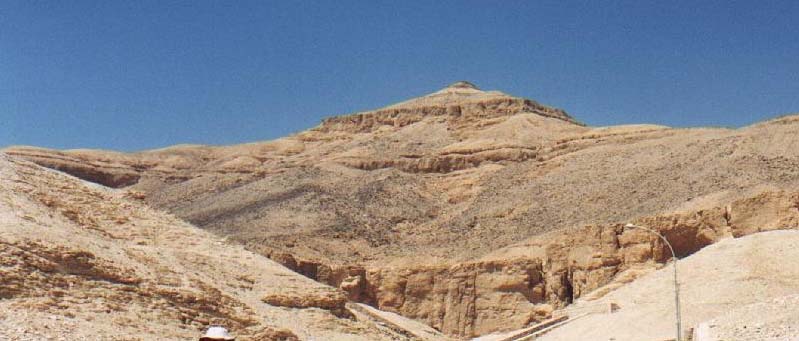
Decorations in the tombs vary greatly. Usually the sacred texts cover the walls and sarcophagus, collectively known as the 'Books of the Dead'. The text, was intended to aid the deceased, on his journey through the netherworld.
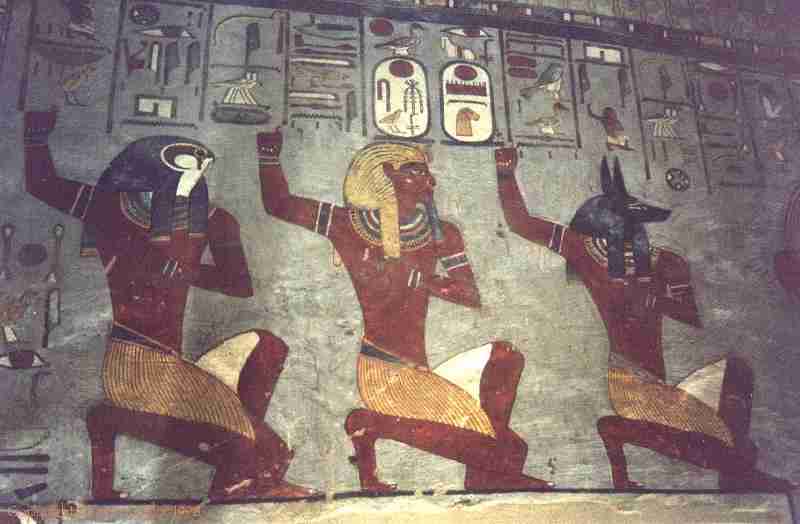
Horus, Ramses I, Anubis
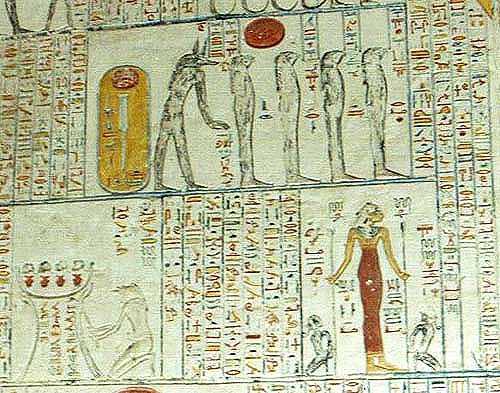
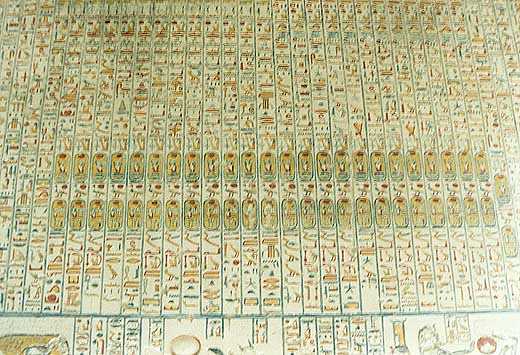
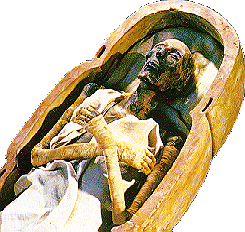
The tomb is sometimes referred to as the "Harpers Tomb" due to the two harpers playing to the gods in four of the chambers. Ten small chambers branch off of the main corridors. These were for the placement of tomb furniture.
Three white corridors descend to the sarcophagus chamber. The chambers ceilings depict the goddess Nut. The lid of the pink granite sarcophagus is decorated with Isis and Nephthys, which were meant to serve as guardians over the body. Their duties fell short, however, as the tomb was robbed in ancient times. Originally the priests placed the sarcophagus in Amenhotep II II's tomb in order to hide the body, which was a common practice.
Two sets of steps lead down to the tomb door that is decorated with the Pharaoh worshipping the solar disc. Isis and Nephthys stand behind him on either side. Three corridors lead into an antechamber that opens into a pillared hall. The passage beyond that leads to the sarcophagus chamber.
The steep descent into the tomb is typical of the designs of the XIX Dynasty. The entrance is decorated with Isis and Nephthys worshipping the solar disc. Text from the 'Book of the Gates' line the corridors. The outer granite lid of the sarcophagus is located in the antechamber, while the lid of the inner sarcophagus is located down more steps in the pillared hall. Carved on the pink granite lid is the figure of Merneptah as Osiris.
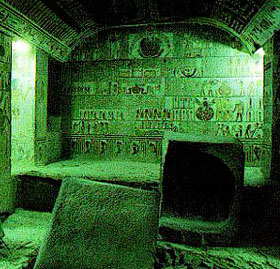
Originally built for Ramesses V, three chambers and a 4th pillared chamber was added by Ramesses VI. Complete texts of the Book of the Gates, the Book of Caverns and the Book of Day and Night line the chambers. Portions of the Book of the Dead are located in the pillared chamber, along with scenes of the skygoddess, Nut.
The longest tomb in the valley, 100m, contains very well preserved reliefs in all of its eleven chambers and side rooms. One of the back chambers is decorated with the Ritual of the Opening of the Mouth, which stated that the mummy's eating and drinking organs were properly functioning. Believing in the need for these functions in the afterlife, this was a very important ritual. The sarcophagus is now in the Sir John Soane Museum, London.
The tomb of Tuthmose III is at the far end of the East Valley and is one of the earliest in the Valley. Its burial chamber is in the shape of a cartouche (oval-shaped) and its inscriptions are interspersed with stick figures. The approach to this unusual tomb is an ascent up wooden steps, crossing over a pit, and then a steep descent down into the tomb. The pit was probably dug as a deterrent to tomb robbers. Two small chambers, decorated with stars, and a larger vestibule are in front of the sarcophagus chamber, which is uniquely rounded and decorated with only red and black.
A steep flight of stairs and a long unadorned corridor lead to the sarcophagus chamber. Three mummies, Tuthmosis IV, Amenhotep II III and Seti II, were found in one side room and nine mummies were found in another.
This tomb's construction is identical to that of Seti I's with the exception of some of the inner decorations.
Ancient Flowers Found in Egypt Coffin in Egypt's Valley of the Kings "KV 63" National Geographic - June 30, 2006 - Follow-up story to those below
BBC - February 10, 2006
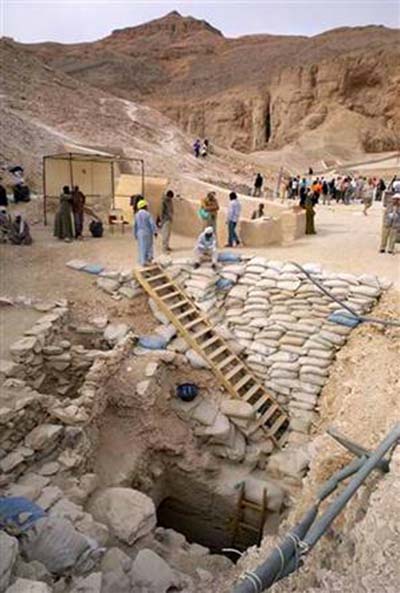
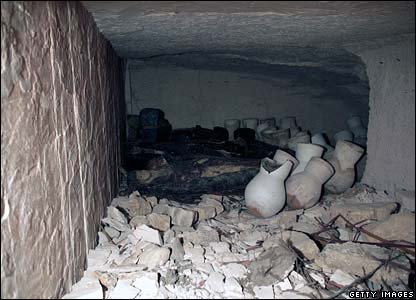
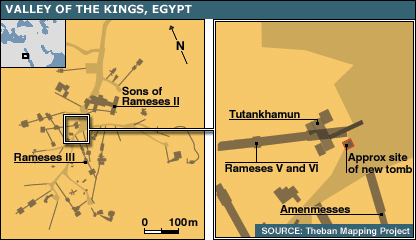
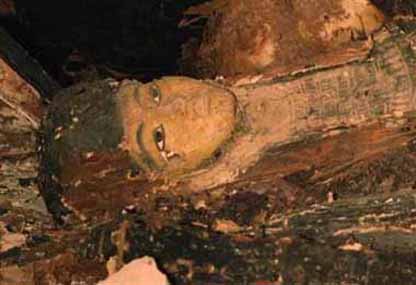
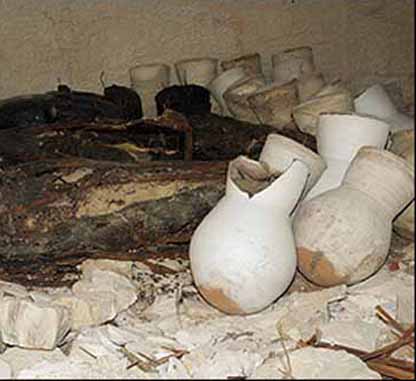
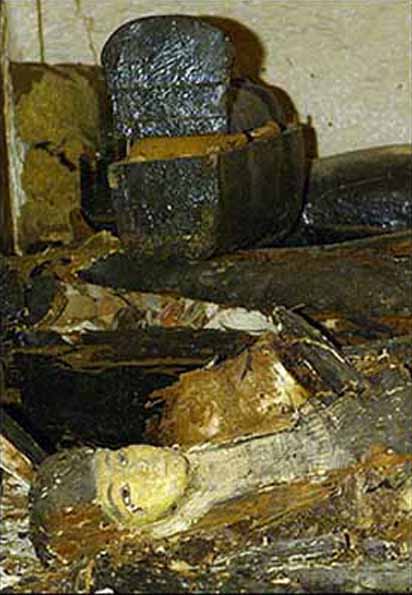
New Tomb Opened in Egypt's Valley of Kings
National Geographic
Archaeologists have discovered an intact, ancient Egyptian tomb in the Valley of the Kings, the first since King Tutankhamun's Tomb was found in 1922. The tomb contains five sarcophagi with mummies, breaking the nearly century long belief that there's nothing more to find in the valley where some of Egypt's greatest pharaohs were buried.
Found in the tomb was the red granite head of King Amenhotep III - father of the Pharaoh Akhenaten.
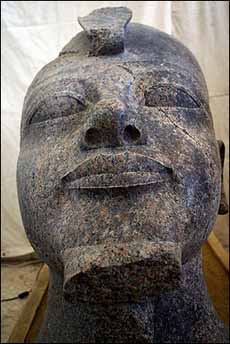
Researchers discover 3,400-year-old artifact depicting Queen Ti MSNBC - January 25, 2006
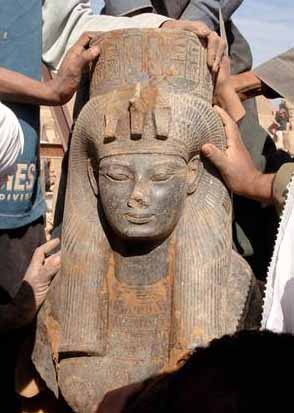
Egyptologists have discovered a statue of Queen Ti, wife of one of Egypt¹s greatest pharaohs and grandmother to the boy-king Tutankhamun, at an ancient temple in Luxor, an Egyptian antiquities official said. The roughly 3,400-year-old statue was well-preserved. Ti's husband, Amenhotep III, presided over an era which saw a renaissance in Egyptian art. A number of cartouches, or royal name signs, of Amenhotep III were found on the statue, and the statue's design and features allowed researchers to identify it as a New Kingdom, 18th Dynasty statue of Queen Ti.
Akhenaten was the son of Amenhotep III and Queen Tiy, a descendent of a Hebrew tribe.
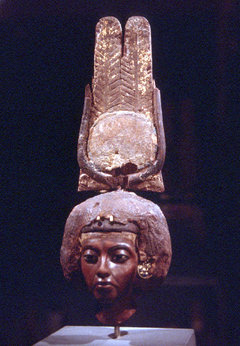
Queen Tiy wearing a double feathered crown




0 comments:
Post a Comment